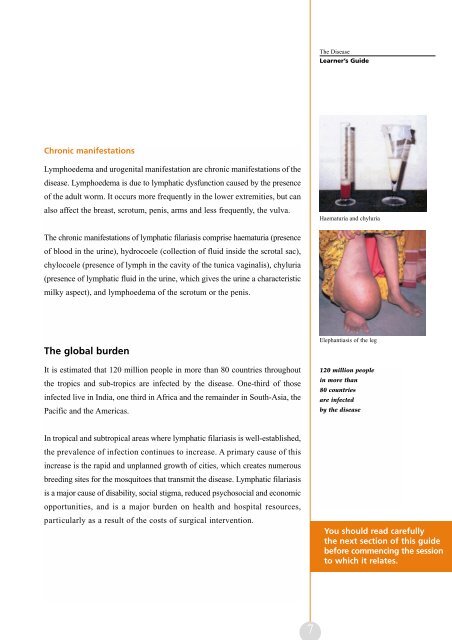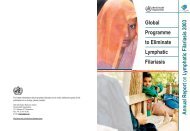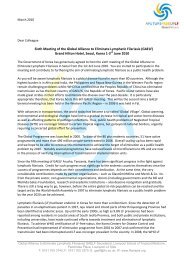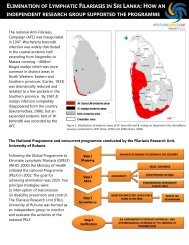Learner's Guide - Global Alliance to Eliminate Lymphatic Filariasis
Learner's Guide - Global Alliance to Eliminate Lymphatic Filariasis
Learner's Guide - Global Alliance to Eliminate Lymphatic Filariasis
You also want an ePaper? Increase the reach of your titles
YUMPU automatically turns print PDFs into web optimized ePapers that Google loves.
The Disease<br />
Learner’s <strong>Guide</strong><br />
Chronic manifestations<br />
Lymphoedema and urogenital manifestation are chronic manifestations of the<br />
disease. Lymphoedema is due <strong>to</strong> lymphatic dysfunction caused by the presence<br />
of the adult worm. It occurs more frequently in the lower extremities, but can<br />
also affect the breast, scrotum, penis, arms and less frequently, the vulva.<br />
Haematuria and chyluria<br />
The chronic manifestations of lymphatic filariasis comprise haematuria (presence<br />
of blood in the urine), hydrocoele (collection of fluid inside the scrotal sac),<br />
chylocoele (presence of lymph in the cavity of the tunica vaginalis), chyluria<br />
(presence of lymphatic fluid in the urine, which gives the urine a characteristic<br />
milky aspect), and lymphoedema of the scrotum or the penis.<br />
The global burden<br />
It is estimated that 120 million people in more than 80 countries throughout<br />
the tropics and sub-tropics are infected by the disease. One-third of those<br />
infected live in India, one third in Africa and the remainder in South-Asia, the<br />
Pacific and the Americas.<br />
Elephantiasis of the leg<br />
120 million people<br />
in more than<br />
80 countries<br />
are infected<br />
by the disease<br />
In tropical and subtropical areas where lymphatic filariasis is well-established,<br />
the prevalence of infection continues <strong>to</strong> increase. A primary cause of this<br />
increase is the rapid and unplanned growth of cities, which creates numerous<br />
breeding sites for the mosqui<strong>to</strong>es that transmit the disease. <strong>Lymphatic</strong> filariasis<br />
is a major cause of disability, social stigma, reduced psychosocial and economic<br />
opportunities, and is a major burden on health and hospital resources,<br />
particularly as a result of the costs of surgical intervention.<br />
You should read carefully<br />
the next section of this guide<br />
before commencing the session<br />
<strong>to</strong> which it relates.<br />
7













